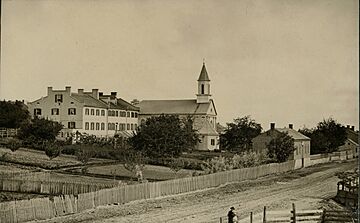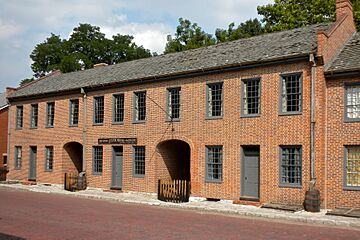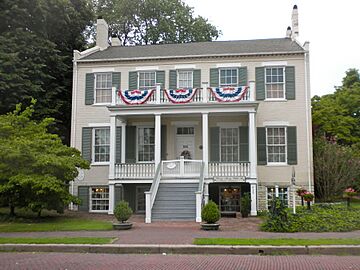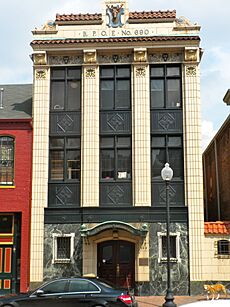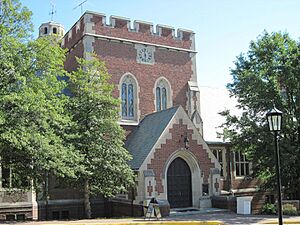St. Charles, Missouri facts for kids
Quick facts for kids
St. Charles, Missouri
|
||
|---|---|---|
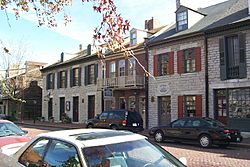
Historic Main Street
|
||
|
||
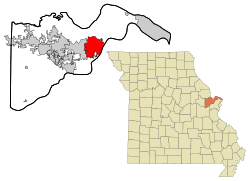
Location in the state of Missouri
|
||
| Country | United States | |
| State | Missouri | |
| County | Saint Charles | |
| Named for | Charles Borromeo | |
| Area | ||
| • Total | 25.67 sq mi (66.48 km2) | |
| • Land | 25.17 sq mi (65.19 km2) | |
| • Water | 0.50 sq mi (1.29 km2) | |
| Population
(2020)
|
||
| • Total | 70,493 | |
| • Density | 2,800.79/sq mi (1,081.40/km2) | |
| Demonym(s) | St. Charlesian | |
| Time zone | UTC−6 (CST) | |
| • Summer (DST) | UTC−5 (CDT) | |
| ZIP Codes |
63301-63304
|
|
| Area codes | 636, 314 | |
| FIPS code | 29-64082 | |
| Website | www.stcharlescitymo.gov | |
St. Charles is a city in Missouri, United States. It's the main city of St. Charles County. In 2020, about 70,493 people lived there. This makes St. Charles the ninth-largest city in Missouri. It's located on the Missouri River, just northwest of St. Louis.
The city started around 1769. It was first called "Les Petites Côtes" by a French-Canadian fur trader named Louis Blanchette. This means "The Little Hills" in French. St. Charles is the third-oldest city in Missouri. It was an important river port for people moving west in the United States. It was also the starting point for the Boone's Lick Road.
Many early settlers in St. Charles spoke French. In 1804, the famous Lewis and Clark Expedition stopped here. It was their last "civilized" stop before they explored the western lands. These lands were bought by the United States in the Louisiana Purchase. From 1821 to 1826, St. Charles was the first capital of Missouri. It is also home to the Saint Rose Philippine Duchesne shrine.
Contents
History of St. Charles
People have lived in the St. Charles area for a very long time. Native American tribes were here as early as 11,000 B.C. When Europeans arrived, the Ilini, Osage, and Missouri tribes lived here.
Louis Blanchette settled in the area around 1769. He was given authority by the Spanish governor. Even though Spain ruled the area, most settlers were Native American and French Canadians. They mostly spoke French.
The Boone's Lick Road started in St. Charles. This road was a main path for European-American settlers. They used it to move into central and western Missouri. This area became known as the "Boonslick Country."
San Carlos Borromeo and Early Days
The first church in St. Charles was Catholic. It was built in 1791 and named after an Italian saint, Charles Borromeo. The Spanish name for the saint was San Carlos Borromeo. Because of the church, the town became known as San Carlos del Misuri. Today, a replica of the first church is near Main Street. The fourth St. Charles Borromeo Church is now on Fifth Street.
The town's name, San Carlos, later became "St. Charles" in English. William Clark arrived in St. Charles on May 16, 1804. He had 40 men and three boats. They got ready for their big trip across the country. They waited for Meriwether Lewis to arrive from St. Louis. The townspeople were very welcoming to the explorers.
Lewis arrived on May 20. The expedition started the next day at 3:30 pm. St. Charles was the last European-American town they saw for over two and a half years.
Missouri's First Capital
Missouri became a state in 1821. The state decided to build a new capital city called "Jefferson City." This new city would be in the middle of the state. But the land for Jefferson City was not ready yet. So, a temporary capital was needed.
St. Charles was chosen over eight other cities. The city offered free meeting space for the government. These rooms were above a hardware store. This building is now the First Missouri State Capitol State Historic Site. You can visit it today. The Missouri government met there until 1826. That's when the buildings in Jefferson City were finished.
A German visitor named Gottfried Duden came to the area in 1824. He wrote about his time in St. Charles County. His writings made many Germans want to move there in 1833.
After World War II, the U.S. government built many interstate highways. St. Charles claims to be where the first interstate project started in 1956. A sign near Interstate 70 mentions this claim.
Geography and Climate
St. Charles is about 20 miles northwest of St. Louis. The city covers about 24 square miles. Most of this area is land, with a small part being water.
St. Charles Weather
St. Charles has a humid subtropical climate. This means summers are warm and humid, sometimes very hot. Winters are cool, with some cold spells. Rain is usually light to moderate. Spring is the wettest season.
| Climate data for St. Charles, Missouri (1991–2020 normals, extremes 1893–present) | |||||||||||||
|---|---|---|---|---|---|---|---|---|---|---|---|---|---|
| Month | Jan | Feb | Mar | Apr | May | Jun | Jul | Aug | Sep | Oct | Nov | Dec | Year |
| Record high °F (°C) | 82 (28) |
84 (29) |
93 (34) |
94 (34) |
101 (38) |
106 (41) |
115 (46) |
112 (44) |
106 (41) |
97 (36) |
87 (31) |
77 (25) |
115 (46) |
| Mean maximum °F (°C) | 64.4 (18.0) |
69.9 (21.1) |
78.1 (25.6) |
84.6 (29.2) |
89.1 (31.7) |
93.0 (33.9) |
96.1 (35.6) |
96.3 (35.7) |
91.6 (33.1) |
86.4 (30.2) |
74.9 (23.8) |
66.7 (19.3) |
97.9 (36.6) |
| Mean daily maximum °F (°C) | 39.5 (4.2) |
44.7 (7.1) |
55.2 (12.9) |
66.8 (19.3) |
76.0 (24.4) |
84.1 (28.9) |
88.0 (31.1) |
86.8 (30.4) |
80.4 (26.9) |
68.8 (20.4) |
55.3 (12.9) |
44.1 (6.7) |
65.8 (18.8) |
| Daily mean °F (°C) | 30.7 (−0.7) |
35.0 (1.7) |
44.4 (6.9) |
55.4 (13.0) |
65.5 (18.6) |
74.2 (23.4) |
78.2 (25.7) |
76.3 (24.6) |
68.8 (20.4) |
57.3 (14.1) |
45.3 (7.4) |
35.2 (1.8) |
55.5 (13.1) |
| Mean daily minimum °F (°C) | 21.9 (−5.6) |
25.2 (−3.8) |
33.7 (0.9) |
44.0 (6.7) |
55.1 (12.8) |
64.3 (17.9) |
68.3 (20.2) |
65.8 (18.8) |
57.2 (14.0) |
45.7 (7.6) |
35.3 (1.8) |
26.4 (−3.1) |
45.2 (7.3) |
| Mean minimum °F (°C) | 3.2 (−16.0) |
8.4 (−13.1) |
16.9 (−8.4) |
30.0 (−1.1) |
40.1 (4.5) |
52.3 (11.3) |
57.1 (13.9) |
56.1 (13.4) |
43.9 (6.6) |
30.7 (−0.7) |
20.1 (−6.6) |
10.0 (−12.2) |
0.2 (−17.7) |
| Record low °F (°C) | −25 (−32) |
−24 (−31) |
−7 (−22) |
17 (−8) |
30 (−1) |
41 (5) |
47 (8) |
43 (6) |
31 (−1) |
19 (−7) |
−4 (−20) |
−19 (−28) |
−25 (−32) |
| Average precipitation inches (mm) | 2.74 (70) |
2.86 (73) |
3.63 (92) |
5.11 (130) |
5.45 (138) |
4.35 (110) |
4.20 (107) |
4.07 (103) |
3.08 (78) |
3.50 (89) |
3.73 (95) |
2.99 (76) |
45.71 (1,161) |
| Average snowfall inches (cm) | 4.3 (11) |
2.6 (6.6) |
0.5 (1.3) |
0.0 (0.0) |
0.0 (0.0) |
0.0 (0.0) |
0.0 (0.0) |
0.0 (0.0) |
0.0 (0.0) |
0.0 (0.0) |
0.1 (0.25) |
1.5 (3.8) |
9.0 (23) |
| Average precipitation days (≥ 0.01 in) | 7.5 | 6.9 | 9.7 | 10.3 | 11.4 | 9.1 | 8.4 | 7.3 | 7.0 | 8.2 | 8.1 | 7.1 | 101.0 |
| Average snowy days (≥ 0.1 in) | 2.1 | 1.8 | 0.3 | 0.0 | 0.0 | 0.0 | 0.0 | 0.0 | 0.0 | 0.0 | 0.4 | 1.0 | 5.6 |
| Source: NOAA | |||||||||||||
People of St. Charles
| Historical population | |||
|---|---|---|---|
| Census | Pop. | %± | |
| 1850 | 1,498 | — | |
| 1860 | 3,239 | 116.2% | |
| 1870 | 5,570 | 72.0% | |
| 1880 | 5,014 | −10.0% | |
| 1890 | 6,161 | 22.9% | |
| 1900 | 7,982 | 29.6% | |
| 1910 | 9,437 | 18.2% | |
| 1920 | 8,503 | −9.9% | |
| 1930 | 10,491 | 23.4% | |
| 1940 | 10,803 | 3.0% | |
| 1950 | 14,314 | 32.5% | |
| 1960 | 21,189 | 48.0% | |
| 1970 | 31,834 | 50.2% | |
| 1980 | 37,379 | 17.4% | |
| 1990 | 54,555 | 46.0% | |
| 2000 | 60,321 | 10.6% | |
| 2010 | 65,794 | 9.1% | |
| 2020 | 70,493 | 7.1% | |
| U.S. Decennial Census | |||
In 2020, the 2020 United States census counted 70,493 people in St. Charles. There were about 29,051 households. The population density was about 2,800 people per square mile.
Most people in St. Charles are white (79.23%). About 7.75% are Black or African-American. About 3.28% are Asian. People of Hispanic or Latino background made up 5.7% of the population.
About 17.3% of the people were under 18 years old. The average age in the city was 37.6 years.
Economy and Jobs
St. Charles has many different types of jobs. Here are some of the top employers in the city, based on a 2015 report:
| # | Employer | # of Employees |
|---|---|---|
| 1 | Ameristar Casinos | 1,620 |
| 2 | St. Charles County | 1,500 |
| 3 | SSM St. Joseph Health Center | 1,352 |
| 4 | Boeing | 1,170 |
| 5 | City of St. Charles School District | 852 |
| 6 | Client Services Inc. | 698 |
| 7 | Lindenwood University | 618 |
| 8 | AT&T Missouri | 600 |
| 9 | Central States Coca-Cola | 500 |
| 10 | City of St. Charles | 494 |
Pharma Medica is a company that does medical research. They opened their first U.S. office in St. Charles in 2013. They planned to create 320 high-tech jobs by 2017.
Culture and Fun Things to Do
St. Charles is near the end of the Katy Trail. This is a 225-mile long state park made from an old railroad path. The St. Charles area has grown a lot since the late 1970s. Many new homes and businesses have been built.
St. Charles has a historic shopping area on Main Street. Many old buildings have been fixed up. They now hold restaurants and unique stores. You can even take walking food tours on Historic Main Street. These tours visit famous local restaurants.
The city also has many events about the Lewis and Clark Expedition. In 2007, St. Charles hosted a bike race. It was the final stage for the 2007 Tour of Missouri.
The St. Charles Parks and Recreation System has a dog park. It opened in 2006 and has areas for both small and large dogs.
The St. Charles Convention Center brings many visitors to the city. The Family Arena is a large venue with 11,000 seats. It hosts sports teams, concerts, and other events.
Riverfront and Main Street Events
The Riverfront and Main Street area is a main gathering spot. It has homes, shops, restaurants, and offices. There are plans to make the area even better. These plans include extending the Katy Trail and adding more businesses.
The Christmas Traditions Festival happens every year. It starts after Thanksgiving and lasts until the Saturday after Christmas. Over 30 people dressed as Christmas characters walk the streets. Victorian-era carolers sing old songs. On Saturdays and Sundays, the characters and the Lewis & Clark Fife and Drum Corps march in a parade.
On the Fourth of July, St. Charles has fireworks displays. This festival is called Riverfest. It draws many people to the city.
The Festival of the Little Hills is a historic tradition. It takes place every August. It started in 1971 and includes food, live music, and craft sales. Some people dress in old clothes to re-enact history.
Oktoberfest celebrates the city's German history. It's held near the river with German food and beer. Missouri Tartan Day celebrates Scottish American heritage. It happens every spring with bagpipers and Scottish games.
Other events include the Fete de Glace (ice carving), the Missouri River Irish Festival, and Quilts on Main Street. The Bluegrass Festival and MOSAICS Fine Art Festival are also held in September. Pride St. Charles holds an annual pride festival in June.
Sports Teams
St. Charles has been home to several minor league sports teams. The Missouri River Otters hockey team played from 1999 to 2006. They played at the Family Arena. The St. Louis Ambush is a professional indoor soccer team. They also play at the Family Arena. The RiverCity Rage was an indoor football team that played here.
| Team | Sport | League | Established | Venue | Championships |
|---|---|---|---|---|---|
| St. Louis Ambush | Indoor soccer | MISL/PASL/MASL | 2013 | Family Arena | |
| St. Louis Vipers | Roller hockey | National Roller Hockey League | 2019 | Family Arena |
Education in St. Charles
The City of St. Charles School District has several schools. There are six elementary schools, two middle schools, and two high schools. The Lewis & Clark Career Center is also part of the district.
St. Charles High School was built in 1895. It was first a private military school for boys. In the 1950s, it became a public high school. St. Charles West was built later, in the 1970s. This was because the city's population was growing. Both high schools have been updated over the years.
There are also many private schools in St. Charles. Most of these schools are connected to a religious group. Examples include Immanuel Lutheran, Zion Lutheran, and St. Charles Borromeo. Academy of the Sacred Heart was founded by Saint Rose Philippine Duchesne. Duchesne High School is another private school.
Some parts of St. Charles are served by other school districts. These include the Francis Howell School District and the Orchard Farm School District.
Lindenwood University
Lindenwood University is a college located in St. Charles. It was started in 1827 by Major George Sibley and his wife Mary. It was first a school for girls. It is the second-oldest college west of the Mississippi River. The university is connected to the Presbyterian Church.
Lindenwood University is one of the fastest-growing universities in the Midwest. It has almost 15,000 students. The university also has a student-run radio station called 89.1 The Wood (KCLC).
Transportation
| Proposed St. Charles City Streetcar | |
|---|---|
| Overview | |
| Locale | St. Charles, Missouri |
| Stations | 5 (proposed) |
| Service | |
| Type | Streetcar |
| Operator(s) | St. Charles Area Transit |
| Technical | |
| Line length | 10-mile (16 km) |
| Track gauge | 1,435 mm (4 ft 8 1⁄2 in) |
The FHA says St. Charles was the site of the first interstate highway project. Major highways that go through St. Charles include Interstates 64 and 70. Other important roads are Missouri 370, Missouri 94, and Missouri 364.
There was a plan for a "St. Charles City Streetcar." This would have been a new streetcar line. It would connect a neighborhood called New Town to the center of St. Charles. Old streetcars were bought for this project. However, the project stopped. The company involved went out of business.
Famous People from St. Charles
Many notable people have connections to St. Charles:
- Cody Asche (born 1990) – MLB player
- Brandon Bollig (born 1987) – NHL player
- Daniel Boone (1734–1820) – famous pioneer; lived in St. Charles for a time
- Lou Brock (1939–2020) – MLB player and Hall of Famer
- Mark Buehrle (born 1979) – MLB player
- Rose Philippine Duchesne (1769–1852) – Catholic saint who started schools
- Josh Harrellson (born 1989) – NBA player
- Tim Hawkins (born 1968) – comedian and singer
- Randy Orton (born 1980) – WWE wrestler
- Jean Baptiste Point du Sable (before 1750–1818) – frontier trader, first non-native settler of Chicago
- Tim Ream (born 1987) – professional soccer player
- Santino Rice (born 1974) – fashion designer and TV personality
- Patrick Schulte (born 2001) – professional soccer player and Olympian
- Jeanne Shaheen (born 1947) – United States Senator
- Jacob Turner (born 1991) – MLB player
Sister Cities
St. Charles has "sister city" relationships with cities in other countries. This helps build friendships and understanding.
 – Ludwigsburg, Baden-Württemberg, Germany (since 1996)
– Ludwigsburg, Baden-Württemberg, Germany (since 1996) – Carndonagh, County Donegal, Ireland (since 2012)
– Carndonagh, County Donegal, Ireland (since 2012) – Inishowen, Ireland (since 2018)
– Inishowen, Ireland (since 2018)
See also
 In Spanish: St. Charles (Misuri) para niños
In Spanish: St. Charles (Misuri) para niños



